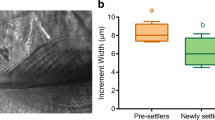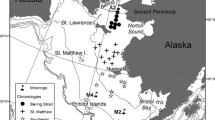Synopsis
The development of the sensory barbels of the tropical goatfish, Upeneus tragula (Mullidae), was examined from their first appearance early in planktonic life through to the reef-associated juvenile period. The structure of the barbel was examined histologically and found to represent an outgrowth of the gustatory (taste) system, composed of at least 50% sensory tissue at settlement. Abrupt changes in morphology were found to be coincident with the 6–12 h settlement period: barbels rapidly moved forward along the hyoid arch to abut the dentary; the length of the barbels increased by up to 52%; the epidermal layer increased to comprise 75% of the cross-sectional area; and the mean size of the taste bud cells increased by up to 100%. A strong relationship was found between barbel length and mean taste-bud size. This relationship was used to predict the mean taste-bud sizes for 237 newly-settled fish, collected as 12 samples over two recruitment seasons. Mean taste-bud size varied significantly among samples. Experiments examined whether food availability or temperature of the water within the pelagic phase influenced the size of the barbels at settlement. Food availability influenced the relationship between barbel length and fish size. Slower growing fish had larger barbels relative to fish length than those that grew faster. Temperature did not influence the relationship between barbel length and fish size. Variability in sensory development at settlement, and the factors which influence it, may have important ramifications for the potential success of the fish once on the reef.
Similar content being viewed by others
References cited
Balon, E.K. 1985. The theory of saltatory ontogeny and life history models revisited. pp. 13–28. In: E.K. Balon (ed.) Early Life Histories of Fishes: New Developmental, Ecological and Evolutionary Perspectives, Dr W. Junk Publishers, The Hague.
Blaxter, J.H.S. 1988. Pattern and variety in development, pp. 1–58. In: WS. Hoar & D.J. Randall (ed.) Fish Physiology, Volume 11a, Academic Press, San Diego.
Brothers, E.B. & W.N. McFarland. 1981. Correlations between otolith microstructure, growth, and life history transitions in newly recruited French grunts [Haemulon flavolineatum (Desmarest), Haemulidae]. Rapp. P-v. Reun. Cons. int. Explor. Met. 178: 369–374.
Campana, S.E. 1983. Feeding periodicity and the production of daily growth increments of steelhead trout (Salmo gairdneri) and starry flounder (Platichthys stellatus). Can. J. Zool. 61: 1591–1597.
Campana, S.E. & J.D. Neilson. 1985. Microstructure of fish otoliths. Can. J. Fish. Aquat. Sci. 42: 1014–1032.
Forstner, H., S. Hinterleitner & W. Wieser. 1983. Towards a better definition of ‘metamorphosis’ in Coregonus sp.: biochemical, histological and physiological data. Can. J. Fish. Aquat. Sci. 40: 1224–1232.
Fowler, A.J. 1989. Description, interpretation and use of the microstructure of otoliths from juvenile butterflyfishes (family: Chaetodontidae). Mar. Biol. 102: 167–181.
Fuiman, L.A. 1989. Vulnerability of Atlantic herring larvae to predation by yearling herring. Mar. Ecol. Prog. Ser. 51: 291–299.
Gosline, W.A. 1984. Structure, function and ecology in the goatfishes (family Mullidae). Pacific Science 38: 312–323.
Holland, K.N. 1976. A behavioral and electrophysiological investigation of the taste function of the barbels of an Hawaiian goatfish. M.Sc. Thesis, University of Hawaii, Honolulu 59 pp.
Hovenkamp F. & J.I. Witte. 1991. Growth, otolith growth and RNA/DNA ratios of larval plaice Pleuronectes platessa in the North Sea 1987 to 1989. Mar. Ecol. Prog. Ser. 70: 105–116.
Margulies, D. 1989. Size-specific vulnerability to predation and sensory system development of white seabass, Atractoscion nobilis, larvae. U.S. Fish. Bull. 87: 537–552.
Markle, D.F., P.M. Harris & C.L. Toole. 1992. Metamorphosis and an overview of early-life-history stages in Dover sole Microstomus pacificus. U.S. Fish. Bull. 90: 285–301.
Marshall, S.L. & S.S. Parker. 1982. Pattern identification in the microstructure of sockeye salmon (Oncorhynchus nerka) otoliths. Can. J. Fish. Aquat. Sci. 39: 542–547.
McCormick, M.E. 1992. The influence of pelagic life history on the quality of tropical goatfish (family Mullidae) at settlement. Ph. D. Thesis, James Cook University, Australia. 120 pp.
McCormick, M.I. & B.W. Molony. 1992. Effects of feeding history on the growth characteristics of a reef fish at settlement. Mar. Biol. 114: 165–173.
McCormick, M.I. & B.W Molony. 1993. Effects of temperature during the planktonic stage on the growth characteristics of a reef fish at settlement. Mar. Ecol. Prog. Ser. (in press).
McCormick, M.I. & J. Shand. 1993. Metamorphosis of the visual and barbel sensory systems at settlement in the reef fish Upeneus tragula (family Mullidae). Proc. 7th Int. Coral Reef Symp. (in press).
McFarland, W.N. & E.W. Munz. 1975. The photic environment of clear tropical seas during the day. Vision Res. 15: 1063–1070.
Miller, T.J., L.B. Crowder, J.A. Rice & E.A. Marshall. 1988. Larval size and recruitment mechanisms in fishes: toward a conceptual framework. Can. J. Fish. Aquat. Sci. 45: 1657–1670.
Neilson, J.D. & G.H. Geen. 1982. Otoliths of chinook salmon (Oncorhynchus tshawytscha): daily growth increments and factors influencing their production. Can. J. Fish. Aquat. Sci. 39: 1340–1347.
Noakes, D.L.G. & J.J. Godin. 1988. Ontogeny of behaviour and concurrent developmental changes in sensory systems in teleost fishes. pp. 345–396. In: W.S. Hoar & D.J. Randall (ed.) Fish Physiology, Volume 11b, Academic Press, San Diego.
Pankhurst, N.W. 1992. Ocular morphology of sweet Scorpis lineolatus and spotty Notolabrus celedotus (Pisces: Teleostei) grown in low intensity light. Brain Behav. Evol. 39: 116–123.
Pepin, P., S. Pearre & J.A. Koslow. 1987. Predation on larval fish by Atlantic mackerel, Scomber scombrus, with a comparison of predation by zooplankton. Can. J. Fish. Aquat. Sci. 44: 2012–2018.
Peiler, E. 1986. Towards an explanation of the developmentalstrategy in leptocephalous larvae of marine teleost fishes. Env. Biol. Fish. 15: 3–13.
Pfeiler, E. & A. Luna. 1984. Changes in biochemical composition and energy utilization during metamorphosis of leptocephalous larvae of the bonefish (Albula). Env. Biol. Fish. 10: 243–251.
Pitcher, C.R. 1988. Validation of a technique for reconstructing daily patterns in the recruitment of coral reef damselfish. Coral Reefs 7: 105–111.
Reutter, K. 1982. Taste organ in the barbels of the bullhead. pp. 77–91. In: T.J. Hara (ed.) Chemoreception in Fishes, Elsevier, Oxford.
Reznick, D., E. Lindbeck & H. Bryga. 1989. Slower growth results in larger otoliths: an experimental test with guppies (Poecilia reticulata). Can. J. Fish. Aquat. Sci. 46: 108–112.
Secor, D.H. & J.M. Dean. 1989. Somatic growth effects on the otolith-fish size relationship in young pond-reared striped bass, Morone saxatilis. Can. J. Fish. Aquat. Sci. 46: 113–121.
Shand, J. 1993. Changes in retinal structure during development and settlement of the goatfish Upeneus tragula. Brain Behav. Evol. (in press).
Somers, K.M. 1986. Multivariate allometry and removal of size with principal component analysis. Syst. Zool. 35: 359–368.
Victor, B.C. 1983. Settlement and larval metamorphosis produce distinct marks on the otoliths of the slippery dick, Halichoeres bivittatus. pp. 47–51. In: M.L. Reaka (ed.) The Ecology of Deep and Shallow Coral Reefs, Symposia Series for Undersea Research, NOAA's Undersea Research Program Vol. l.
Yin, M.C. & J.H.S. Blaxter. 1987. Escape speeds of marine fish larvae during early development and starvation. Mar. Biol. 96: 459–468.
Youson, J.H. 1988. First metamorphosis. pp. 135–196. In: W.S. Hoar & D.J. Randall (ed.) Fish Physiology, Volume 11b, Academic Press, San Diego.
Author information
Authors and Affiliations
Rights and permissions
About this article
Cite this article
McCormick, M.I. Development and changes at settlement in the barbel structure of the reef fish, Upeneus tragula (Mullidae). Environ Biol Fish 37, 269–282 (1993). https://doi.org/10.1007/BF00004634
Received:
Accepted:
Issue Date:
DOI: https://doi.org/10.1007/BF00004634




